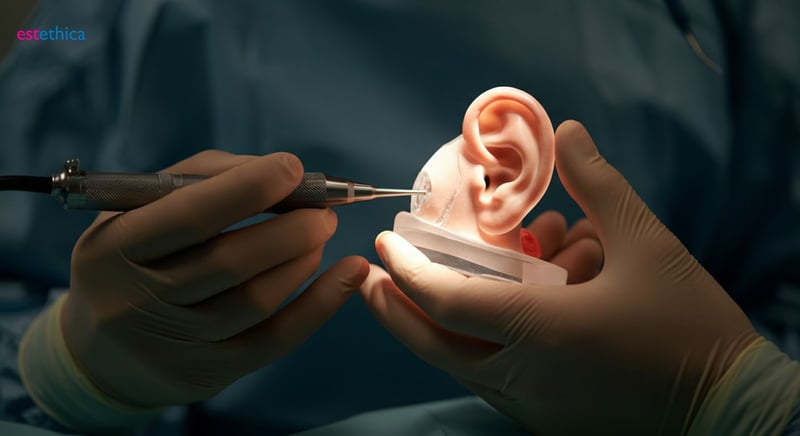Ear Reshaping: Your Guide to Cosmetic Ear Surgery
Unlock the secret to perfect ear symmetry with our expert guide on otoplasty. Your path to aesthetic harmony begins here.
Otoplastic surgery, often referred to as ear reshaping, offers a cosmetic and sometimes functional solution for those seeking to improve the aesthetics and performance of their ears. This guide delves into various aspects of otoplasty—its techniques, benefits, and what one can expect from undergoing this transformative procedure.
Otoplasty Unveiled: Understanding Cosmetic Ear Surgery
Exploring the Nuances of Otoplasty
Otoplasty, often sought to refine ear shape and position, is a personalized cosmetic procedure. It addresses concerns ranging from overly protruding ears to structural irregularities. The procedure aims to bring the ears into better proportion with the head and face. This enhancement often leads to a significant boost in self-confidence for individuals self-conscious about their ear appearance. For instance, someone who has felt the need to hide their ears under long hair might find newfound freedom and confidence after undergoing otoplasty. It's about creating harmony and balance in one's overall appearance.
- Correcting Protruding Ears: Otoplasty can effectively set back ears that stick out too far from the head, creating a more balanced profile.
- Reshaping Irregular Ear Structures: The procedure addresses deformities like cupped or shell ears, enhancing their natural form.
- Restoring Symmetry: Otoplasty can improve ear symmetry, especially in cases where one ear differs significantly from the other.
Ideal Candidates for Otoplasty
Determining candidacy for cosmetic ear surgery involves several factors. Ideal candidates are typically those who are unhappy with the shape, size, or position of their ears. They should be in good overall health, both physically and psychologically, with realistic expectations about what the surgery can achieve. Otoplasty is commonly performed on children after their ears have reached full size, typically around age five or six, as well as on adults of any age. A consultation with a qualified surgeon is essential to assess individual suitability and discuss the potential outcomes of the procedure. Consider, for example, a young adult who has been self-conscious about their protruding ears since childhood or an individual with ears misshapen from an injury seeking reconstructive options. Otoplastic surgery can provide a transformative solution for diverse needs.
- Initial Consultation: A comprehensive evaluation of ear structure and discussion of patient goals.
- Surgical Planning: Customized plan based on individual anatomy and desired aesthetic outcome.
- Post-operative Care: Detailed instructions for recovery, including wound care and activity restrictions.

Ear Pinning: Correcting Protruding Ears for Enhanced Harmony
Understanding the Ear Pinning Procedure
Ear pinning, or pinnaplasty, is a specific otoplasty surgery technique focused on moving the ears closer to the head. This procedure addresses protruding ears, which can be a source of insecurity, and offers a solution that enhances facial symmetry and harmony. The goal of ear pinning is to reshape the cartilage of the ear to reduce its projection. For example, a child who has been teased about their prominent ears or an adult who has always felt self-conscious can benefit. This adjustment can lead to a more balanced and proportionate appearance. The surgery involves reshaping the cartilage and securing it with sutures to maintain the new position. Cosmetic ear surgery, therefore, improves overall aesthetic and psychological well-being.
- Cartilage Reshaping: Modifying the ear cartilage to reduce protrusion.
- Suturing Techniques: Securing the ear in its new, corrected position.
- Minimal Scarring: Incisions are typically made behind the ear to hide scars.
What to Expect During Ear Pinning Recovery
The recovery from ear pinning involves several key steps to ensure proper healing and optimal results. Immediately following the surgery, a dressing is applied to protect the ears and maintain their new position. Pain is typically managed with medication, and patients are advised to avoid strenuous activities that could impact the healing process. Regular follow-up appointments with the surgeon are crucial to monitor progress and address any concerns. For instance, a patient might need to wear a headband at night for several weeks to prevent the ears from shifting. Proper care and adherence to the surgeon's instructions are essential for a smooth and successful recovery. It is important to ask about otoplasty cost during your consultation. Understanding these steps helps in achieving the desired aesthetic outcome.
- Initial Dressing: Protective dressing applied immediately post-surgery to support the ears.
- Pain Management: Medication prescribed to alleviate discomfort during the initial recovery phase.
- Follow-Up Appointments: Regular check-ups to monitor healing and ensure proper ear positioning.

Pinnaplasty Techniques: Reshaping Ears with Precision
Innovations in Ear Reshaping Methods
Pinnaplasty employs a variety of sophisticated techniques tailored to each patient's specific needs, whether it's adjusting the angle of the ears or reducing their size. The precision of these methods ensures natural-looking results, enhancing both the aesthetic appearance and functional aspects of the ears. Surgeons often use advanced imaging to plan these procedures, ensuring that the outcomes align with the patient's facial structure and desired look. These techniques are not one-size-fits-all; rather, they are carefully selected and adapted to meet individual anatomical and aesthetic goals. The aim is to create a harmonious balance that enhances overall facial aesthetics. Otoplasty surgery is a very important procedure that requires expertise.
- Suture Techniques: Permanent sutures reshape and secure cartilage.
- Cartilage Scoring: Controlled incisions soften cartilage for easier reshaping.
- Skin Excision: Removal of excess skin to refine ear contours.
Customizing the Surgical Approach
The success of ear surgery hinges on the surgeon's ability to customize the approach. This involves a detailed assessment of the patient's ear structure and a clear understanding of their aesthetic goals. For instance, some patients may seek a subtle adjustment, while others require more significant reshaping. The surgeon must consider factors such as skin elasticity, cartilage thickness, and the overall facial structure to achieve optimal results. The goal is to create a natural-looking outcome that enhances the patient's features without appearing artificial. As patient satisfaction is the most important thing, surgeons take care to explain the otoplasty cost and the benefits of the procedure. This personalized approach ensures that the results are both aesthetically pleasing and in harmony with the individual's unique features.
- Detailed Consultation: Discussing patient expectations and evaluating ear anatomy.
- Surgical Planning: Tailoring the surgical technique to meet specific needs.
- Intraoperative Adjustments: Making real-time modifications to ensure optimal results.

Beyond Aesthetics: The Functional Benefits of Ear Surgery
Restoring Hearing and Correcting Congenital Issues
While ear surgery is often viewed as a cosmetic solution, it can significantly improve functionality. Otoplastic procedures can address congenital ear defects that impact hearing or cause discomfort. Correcting these issues not only enhances appearance but also improves the patient's quality of life. For instance, addressing constricted ear canals can improve auditory capabilities. Correcting structural abnormalities can alleviate physical discomfort and reduce the risk of infections. Functional improvements extend beyond aesthetics, providing tangible health benefits. Understanding the full spectrum of benefits makes cosmetic ear surgery a well-rounded option for many individuals.
- Improved Hearing: Correcting structural issues that impair auditory function.
- Congenital Issue Resolution: Addressing birth defects affecting ear shape and function.
- Enhanced Quality of Life: Alleviating discomfort and improving overall well-being.
Navigating the Financial Aspects of Functional Otoplasty
When considering otoplasty for functional benefits, understanding the financial aspects is essential. While otoplasty cost is a common question, it's important to differentiate between procedures that are purely cosmetic and those that address functional issues. In some cases, insurance may cover a portion of the expenses if the surgery is deemed medically necessary. Factors such as the complexity of the surgery and the surgeon's expertise can influence the overall otoplasty surgery expenses. During your consultation, it's advisable to discuss all potential costs and explore available payment options. At [Your Company Name], we provide detailed consultations to help you understand the financial commitments involved, ensuring transparency and informed decision-making. This way, you can confidently pursue ear pinning and other procedures to enhance both your appearance and well-being.
- Consultation: Discuss functional concerns and potential coverage.
- Detailed Cost Breakdown: Understand all expenses involved in the procedure.
- Financial Planning: Explore payment options and insurance possibilities.
Precision Pinnaplasty: Advanced Cartilage Reshaping for Natural-Looking Ear Correction
estethica employs advanced pinnaplasty techniques, including suture reshaping, cartilage scoring, and skin excision, to customize ear reshaping procedures. These methods ensure that each patient receives a tailored treatment plan, addressing specific needs such as adjusting ear angle or reducing size, for optimal aesthetic and functional outcomes.
estethica's expert surgeons possess extensive experience in otoplasty and pinnaplasty techniques, ensuring precise and natural-looking results. The medical team utilizes advanced imaging technologies for surgical planning, ensuring that outcomes align with the patient's facial structure and desired aesthetic goals.
Patient-Centric Otoplasty: Ensuring Comfort and Optimal Results
estethica prioritizes patient comfort and safety throughout the otoplasty process, from initial consultation to post-operative care. The hospital offers detailed consultations, customized surgical plans, and comprehensive post-operative instructions, ensuring transparency and informed decision-making.
Patients at estethica experience improved self-esteem and satisfaction with their appearance following otoplasty procedures. The hospital’s commitment to natural-looking results and patient-centered care ensures a positive and transformative experience.
Frequently Asked Questions
What is Otoplasty, and who is a good candidate?
What does ear pinning (pinnaplasty) correct?
What are the different techniques used in pinnaplasty?
Are there functional benefits to undergoing ear surgery?
What is the recovery process like after ear pinning?
Achieve your aesthetic goals with estethica's world-class services and expert care.
📞 Book Your Free Consultation!